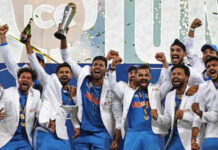The traditional Indian saree is set to make a comeback as the official ceremonial attire for India’s female athletes at the upcoming Paris Olympics, which will take place from July 26 to August 11. It has been absent for eight years.
At the Rio Olympics in 2016, the women athletes wore sarees as ceremonial attire, along with mismatched blue blazers. This time, they will don elegant pre-pleated ikat printed sarees without the traditional blue blazer featuring the Indian Olympic Association’s (IOA) insignia.
Instead, the saree will be complemented by a matching blouse with a pocket displaying the IOA’s insignia. The saffron blouse symbolizes the country’s strength and courage.
Ikat involves tie-dyeing the warp yarns to print woven fabric. The use of sarees as ceremonial attire was halted before the 2018 Commonwealth Games in Gold Coast and the Asian Games in Jakarta/Palembang.
During the Tokyo Games in 2021, women wore traditional golden salwar suits with jackets, while men wore galabandhs (indigenous jackets with high collars). In Paris, men will wear traditional kurta-pyjamas matched with bandi jackets featuring the official insignia.
The IOA gave the green light to the designs on Tuesday following the government’s initiative to embrace tradition at the Games. In the past, Indian male athletes wore blazers or galabandhs with coordinated formal trousers and head turbans. However, this style will not be seen in Paris. For the first time, male athletes will showcase open bandi jackets featuring printed lower panels, cargo pockets, and tape detail, combined with kurtas and trousers.
Both outfits will be crafted from pure cotton fabric in an elegant ivory design, serving a dual purpose beyond just aesthetics. In the midst of the scorching summer temperatures, the light ivory hue will help combat the heat, ensuring our athletes stay cool and comfortable throughout the day.
The attire will feature the tricolour impression, with women athletes pairing saffron blouses and incorporating green and orange ikat printed panels and tapes, representing the green and saffron bands of the national flag, respectively. Men will display the tricolour print on the tape and lower panels of their open bandi jackets.
As per the official partner for ceremonial attire, incorporating the tricolour elements from the Indian flag not only showcases national pride but also deepens the bond between athletes and their cultural roots, fostering a strong sense of unity and patriotism. Moreover, the blue buttonholes symbolize the Ashoka Chakra, a significant emblem on the flag.
This concept was conceived after observing the ceremonial outfits of other participating nations, which historically and traditionally draw inspiration from their flags to symbolize their identity. Each country’s uniform reflects the colors of their flag, embodying their national pride.






















































